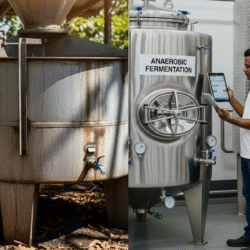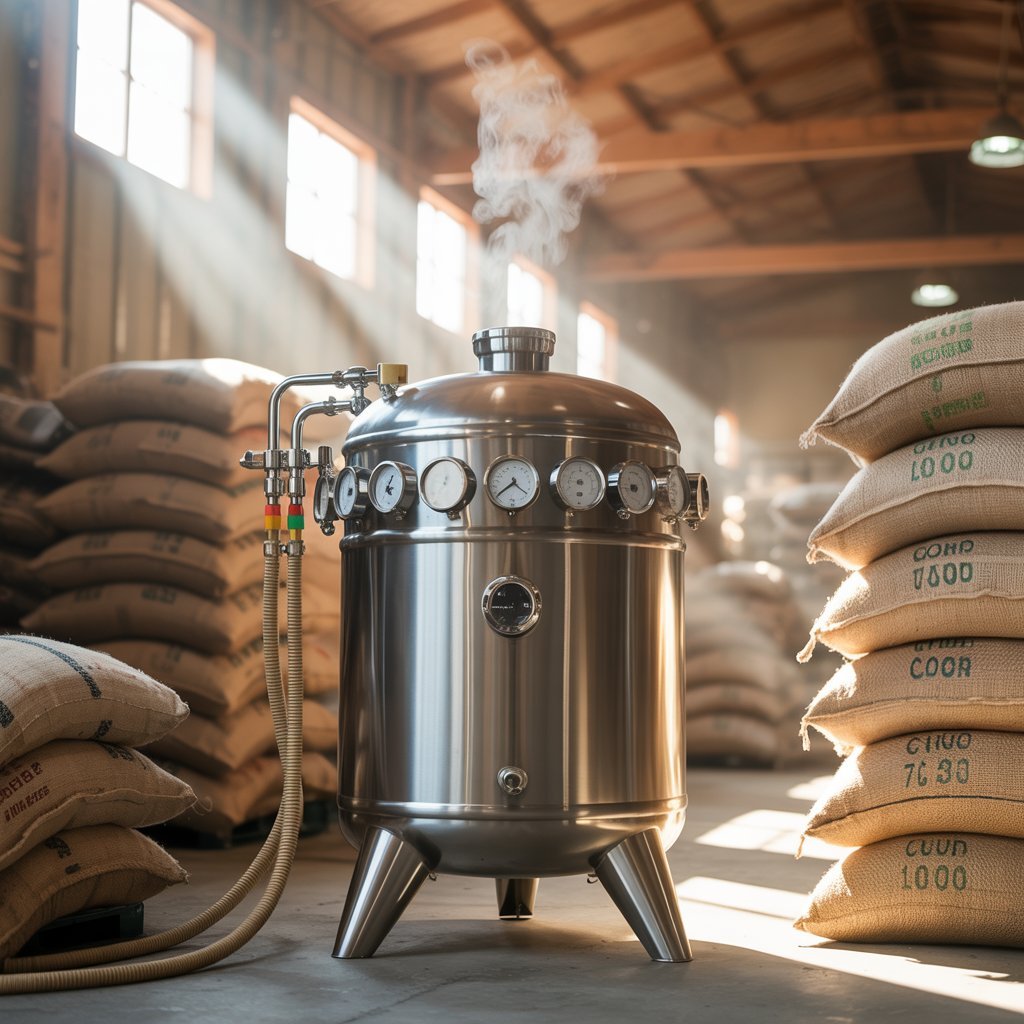In the ever-evolving world of specialty coffee, the conversation has moved far beyond “dark roast vs. light roast.” We now geek out over varietals, terroir, and, most importantly, processing. You’ve likely heard of washed, natural, and honey-processed coffees. But what if we told you that some of the world’s most innovative coffee producers are behaving more like molecular gastronomists, using techniques that sound like they belong in a science lab?
Enter thermal shock.
It’s a method that’s as dramatic as it sounds, involving a deliberate and rapid plunge from hot to cold. This high-risk, high-reward technique is one of the most exciting frontiers in coffee processing, giving producers unprecedented control and unlocking flavor profiles that are startlingly complex and intensely aromatic.
What Exactly is Thermal Shock in Coffee?
At its core, thermal shock is a post-harvest processing technique where coffee cherries are subjected to a rapid, extreme change in temperature. This is not an accident; it’s a meticulously controlled, two-part process:
- The Hot Bath: Freshly picked coffee cherries are first introduced to a hot water bath, often in a sealed, anaerobic (oxygen-free) tank.
- The Cold Plunge: After a specific time, they are immediately “shocked” with a deluge of cold water or an ice bath, causing a drastic drop in temperature.
Think of it like blanching vegetables to lock in their vibrant color and crunch. In coffee, this process is used to manipulate and guide the fermentation that is so crucial for flavor development.
The “Why”: The Goals Behind the Drastic Temperature Swing
Why would a producer go through this complex, energy-intensive process? It all comes down to control and creativity.
1. To Curate a Perfect Fermentation Environment
Traditional fermentation is a bit of a wild party. Whatever microbes are present on the cherry skin and in the air—yeasts, bacteria, fungi—are invited. Sometimes, this creates beautiful flavors. Other times, it leads to undesirable sourness or funky defects.
Thermal shock is the bouncer at the door.
- The Hot Water Kick-Start: The initial heat (often between 40-50°C) is warm enough to kill off many unwanted or weak microbes on the cherry’s exterior. Crucially, it creates the perfect environment for specific, heat-loving (thermophilic) yeasts and bacteria to thrive, effectively kick-starting a “clean” fermentation with a hand-picked team of microbes.
- The Cold Water Hard-Stop: The subsequent cold shock acts as a brake, rapidly halting all microbial activity. This gives the producer the power to stop the fermentation at the exact moment it reaches its peak flavor potential, preventing it from going too far and developing vinegary notes.
2. To Unlock New and Intense Flavor Compounds
The stress induced by the rapid temperature change alters the cellular structure of the coffee cherry. The heat can make the fruit’s skin more permeable, encouraging a deeper infusion of the sugary, fruity mucilage into the bean itself. This stress-induced reaction can lead to the creation of a wider and more intense range of aromatic compounds—the building blocks of flavor and aroma.
3. To Achieve Unprecedented Consistency
One of the biggest challenges in coffee processing is consistency. Ambient temperature can fluctuate, leading to different fermentation results from one day to the next. By controlling the temperature so precisely, producers can create a standardized recipe for fermentation, allowing them to replicate their award-winning flavor profiles batch after batch.
A Walkthrough of the Process: From Cherry to Drying Bed
While pioneers like Diego Bermudez of Finca El Paraiso in Colombia have famously perfected their own methods, a typical thermal shock process follows these key steps:
- Meticulous Selection: Only perfectly ripe cherries with a high sugar content (often measured in Brix) are chosen. The process is too demanding for subpar fruit.
- The First Fermentation (The “Activation”): The cherries are placed in a sealed bioreactor or tank. They might first undergo an initial anaerobic fermentation for a set number of hours.
- The Hot Bath: Hot water is flushed into the tank for a very specific, often short, period. This opens the pores of the cherry and activates the desired microbes.
- The Cold Shock (The “Quench”): The hot water is drained, and the tank is immediately flooded with cold water. This dramatic temperature drop locks in the chemical compounds developed during the hot phase and stops the process cold.
- The Second, Long Fermentation: This is a crucial step. The shock is often just a prelude. After being quenched, the coffee is often left to ferment for a much longer period (from 36 to over 100 hours) at a controlled, cool temperature. The initial shock has essentially “sterilized” the environment and selected the microbes that will now do their slow, methodical work.
- Careful Drying: The flavors created are delicate. The coffee must be dried slowly and evenly, often in temperature-controlled rooms or on shaded raised beds, to preserve the complex aromatics and prevent the development of mold.
The Taste of Innovation: What’s in the Cup?
When executed perfectly, thermal shock coffees are unlike anything else. They are known for being exceptionally clean, explosive, and distinct. Expect a flavor profile that is:
- Intensely Aromatic and Floral: Think perfume, rosewater, jasmine, and lemongrass.
- Complex and Fruity: Often described with notes of peach yogurt, candied strawberry, red grapes, passion fruit, and tropical punch.
- Spiced and Unique: It’s not uncommon to find notes of cinnamon, clove, or pink peppercorn, which are direct byproducts of the specific yeast activity.
- Vibrant and Juicy: The acidity is often bright and complex, like fine wine, but balanced by an incredible sweetness.
The Risk and the Reward
This is not a process for the faint of heart. It requires significant investment in equipment, a deep understanding of microbiology, and an enormous amount of skill and precision. A small miscalculation in temperature or timing can ruin an entire lot.
But for those who master it, the reward is immense. These coffees fetch high prices, win competitions, and offer coffee drinkers a truly unforgettable experience.
The next time you see “Thermal Shock” on a coffee bag, you’ll know it represents more than just a processing method. It represents the pinnacle of human ingenuity and artistry, a scientific dance of hot and cold that went into creating the incredible flavors in your cup. Don’t hesitate to try it.




